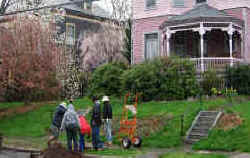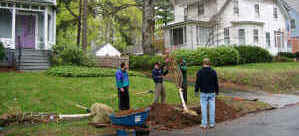|
Maintaining
and
Pruning Your
Trees
On
May 5th, 2007, the first spring
after we planted our trees,
Ron, the arborist
from the Knox Parks Foundation
returned to teach us how to care for our trees.
|
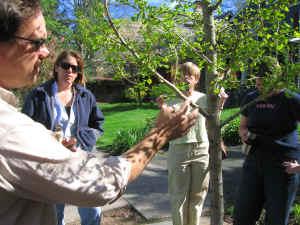 |
Watering: After the first year, do not water
unless there is a drought condition. If you are in
doubt:
if the tree leaves look wilted during a long dry spell, then water
thoroughly with a slow flow or soaker hose.
Ron's tree care philosophy: After the first year, let trees
develop "survival" root systems
so they don't become dependant on constant care. 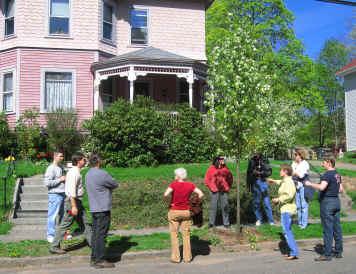 Push any mulch away
that is touching the
trunk.
If your tree does not have a ring of mulch around the bottom,
though, add some.
After the first year, a ring of mulch is primarily to keep lawn
mowers and string trimmers from touching the trunk.
Mowers do more tree damage than anything else. If the string
on a trimmer (or anything else)
girdles the trunk, it kills the tree. Pull any
weeds growing in the mulch ring.
On garbage day, the automated arm that lifts the trash can has gouged many trees
in the city.
Make sure you place your trash cans for pick up far away from your
street trees.
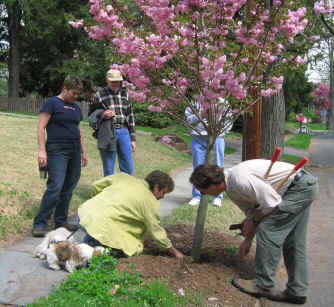 A
tree that was planted crooked
can be pushed back into a straighter position the first spring after
planting
as long as it has roots saturated with water. 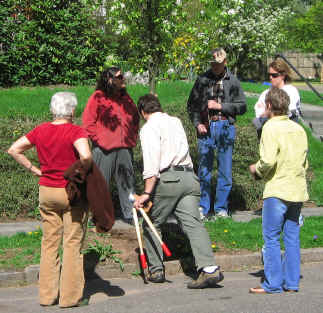
Clip
any "suckers" (growth) coming up from the roots in the
soil.
Flick off any new leaves emerging from the trunk with your thumb.
These look sloppy and sap the energy from growth you want to
promote. 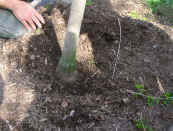
With
sharp pruning shears, clip any dead twigs or
limbs.
Clip at an angle at the base of the limb, just after the
collar
(which is the raised bark at the very base of the limb). The
collar provides extra healing properties. 
Make
sure all old, previously pruned spots are clipped the same way.
This nib should have been pruned at the base - at an angle just after the
collar. Do it now - it invites disease.
If there are any tags or strings with plastic or nylon, remove them
- they will eventually cut into the tree. 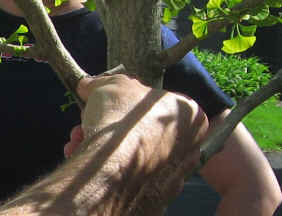
This
tree shows a damaged area that has started to heal.
The light blue-green spots on the bark is lichen. Lichen will
not harm a tree. 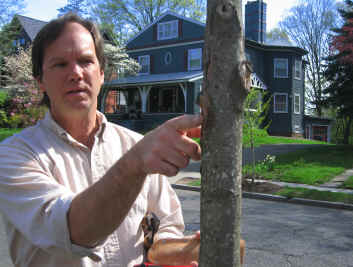
The
year after planting, avoid pruning except in the case of dead
twigs,
suckers at the root ball and limbs that are touching.
Limbs that are touching can rub the bark off in the wind in less
than a season.
If you can't untwist them so they will not rub,
remove the least promising limb. 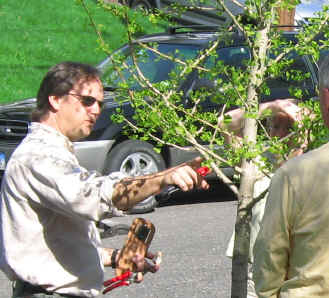
Recap:
First year after planting year:
-
Push mulch from tree trunk.
-
Retain a mulch ring and weed it so that
mowers do not come close to the trunk.
-
Clip suckers from tree roots and trunk.
-
Prune dead twigs and limbs.
-
Prune any limb that is rubbing against
another.
-
Remove any tags, plastic or nylon string.
-
Don't water unless there are drought
conditions and leaves are wilting.
-
Place your trash can far away from street
trees.
Year
Three (after
planting)
May, 2009 Your
trees should grow another year or two before they are pruned
for other reasons,
because the young trees will lose moisture at the pruning site.
After the second year and as the years go by,
prune twigs and limbs:
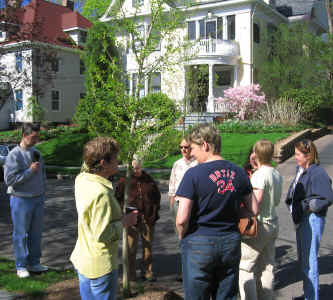
Remove
one of the limbs if two of them are too close to each other.
The weaker is called a sucker
because it will "suck" away the energy, water and nutrients from
a limb you wish to promote.
Suckers that rise straight up from a limb should be removed as
well.
You can prune a limb wherever new growth is -
just remember to cut at an angle and to cut so that you leave the
collar.
For more mature street trees, remove all limbs that are lower than a
person.
Pedestrians should be able to comfortably walk under the tree.
A well-pruned tree has an open feel, so light and air can reach all
parts.
Think of it as a tree a bird can comfortably fly through.
Other info:
Treat Japanese beetle grubs in your lawn with Milky Spore.
It will attack only the Japanese Beetle grub that eats grass
roots, but not beneficial
insects and worms necessary for healthy soil. The treatment
takes a year or so to be fully effective, and lasts at least 10 years.
It will cut down on Japanese beetles that attack
roses and other favorite plants the mature beetle loves to
munch.

 
 Back to Tree Planting page.
Back to Tree Planting page.

|
